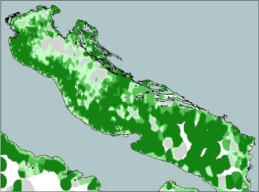Data:DBSEABED: Difference between revisions
No edit summary |
(dbSEABED introduction) |
||
| Line 1: | Line 1: | ||
{{Data description | {{Data description | ||
|One-line data description=dbSEABED | |One-line data description=dbSEABED describes the materials and features of the global seafloor. | ||
|Extended data description=dbSEABED is | |Extended data description=dbSEABED is an integration of all the datasets that deal with the materials and features of the seabed. It holds data describing about 2 million seafloor sites, and integrates that pointwise data using an Information Processing System that has a number of processing steps and options. A unique and advantageous feature is that word-based descriptive data about seafloor bottom type is parsed and brought into conformance with the analytical numeric data type, so that they become co-mappable. This gives the best possible geographic coverage and information richness from the available data. | ||
dbSEABED deals with the grain size textures, strengths and porosities, carbon and carbonate compositions, colors, structural features, and grain components of the seafloor. The diverse inputs on these properties from thousands of individual datasets are harmonized into one standardized and calibrated set of outputs, which initially is pointwise but then is computed into grids and other visualizations. For quality assurance reasons, a significant amount (about 20%) of the original data from the diverse input datasets is not accepted to outputs. | dbSEABED deals with the grain size textures, strengths and porosities, carbon and carbonate compositions, colors, structural features, and grain components of the seafloor. The diverse inputs on these properties from thousands of individual datasets are harmonized into one standardized and calibrated set of outputs, which initially is pointwise but then is computed into grids and other visualizations. For quality assurance reasons, a significant amount (about 20%) of the original data from the diverse input datasets is not accepted to outputs. | ||
The scope of dbSEABED is worldwide, from estuaries across the continental shelves to the very deepest ocean, and dealing with rock and sediment, and the terrigenous, volcanic and biogenic sourced materials. | |||
|Upload image dataset=Adr mudT.jpg | |Upload image dataset=Adr mudT.jpg | ||
|Caption dataset image=Example of | |Caption dataset image=Example of dbSEABED data<br> % mud map of the Adriatic Sea | ||
}} | }} | ||
{{Data format | {{Data format | ||
Revision as of 09:50, 1 March 2010
DBSEABED dataset information page
Short Description
| Example of dbSEABED data % mud map of the Adriatic Sea |
Statement: dbSEABED describes the materials and features of the global seafloor.
Abstract: dbSEABED is an integration of all the datasets that deal with the materials and features of the seabed. It holds data describing about 2 million seafloor sites, and integrates that pointwise data using an Information Processing System that has a number of processing steps and options. A unique and advantageous feature is that word-based descriptive data about seafloor bottom type is parsed and brought into conformance with the analytical numeric data type, so that they become co-mappable. This gives the best possible geographic coverage and information richness from the available data.
dbSEABED deals with the grain size textures, strengths and porosities, carbon and carbonate compositions, colors, structural features, and grain components of the seafloor. The diverse inputs on these properties from thousands of individual datasets are harmonized into one standardized and calibrated set of outputs, which initially is pointwise but then is computed into grids and other visualizations. For quality assurance reasons, a significant amount (about 20%) of the original data from the diverse input datasets is not accepted to outputs.
The scope of dbSEABED is worldwide, from estuaries across the continental shelves to the very deepest ocean, and dealing with rock and sediment, and the terrigenous, volcanic and biogenic sourced materials.
Data format
| Data type: | Substrates |
| Data origin: | Modeled |
| Data format: | ArcExport, ASCII |
| Other format: | |
| Data resolution: | |
| Datum: |
Data Coverage
Spatial data coverage: Global point source measurements
Temporal data coverage: Time snap shot
Time period covered:
Availability
Download data: http://csdms.colorado.edu/wiki/DBSEABED
Data source: http://instaar.colorado.edu/~jenkinsc/dbseabed/
References
- Jenkins, C.J. 2010. Seafloor Substrates. INSTAAR, University of Colorado, Boulder CO USA. (URL: "http://csdms.colorado.edu/wiki/DBSEABED"; Last edit 18 Feb 2010)

